FAK rates are based on fixed price systems. If you have shipments with a variety of goods, you have the option of packing them together as FAK cargo. Much like a cat oozes itself into any available empty space, you can pack different goods together and ship them at the same price with FAK rates. This presents an alternative option to density and size-based shipping.
FAK rates, meaning Freight of All Kinds, are used by freight forwarders and NVOCCs (non-vessel operating common carriers) to provide flat shipping rates by average density or container size. Items eligible for FAK classification can be shipped together. Shipments are charged at a flat rate instead of as unique commodities.
Learn more about FAK rate pricing and qualifications to find new solutions for your business needs.
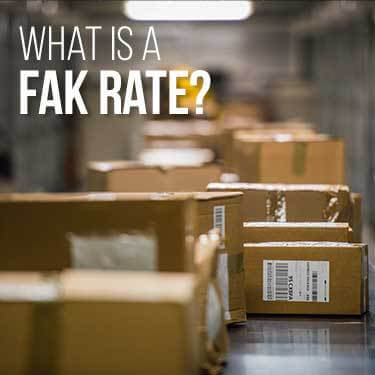
A FAK rate is a type of flat rate pricing in shipping. The abbreviation stands for Freight of All Kinds and is used to show that different types of goods can be shipped together for one price.
Instead of providing shippers with quotes based on each commodity being sent, FAK rates are based on broad options.
The standards depend on what method of shipping you plan on using - ocean or truck.
For international FAK shipping through an NVOCC, rates will depend on the size and type of shipping container you want to use. Any acceptable items that can be placed in the container will ship for the same price.
Ocean carrier rates vary based on the shipping lane and type of container. You also need to consider that those ocean carriers might not make all their containers available for FAK commodities.
FAK rates for LTL (Less Than Truckload) carriers look a little different. Since LTL carriers take on multiple orders of different sizes, basing FAK rates on dimensions is challenging.
Instead, shippers can negotiate a FAK rate based on the average freight class (determined by density) of the items being shipped. Using this method, carriers may customize FAK rates for individual clients and individual shipments.
See our article on LTL Freight Classes for more information on shipping based on density calculations.
FAK rates usually aren’t going to affect pricing if you are moving cargo in full truckloads (FTL). Since FTL shipping doesn’t depend on individual commodities getting priced out, it can actually be thought of as a type of FAK transportation.
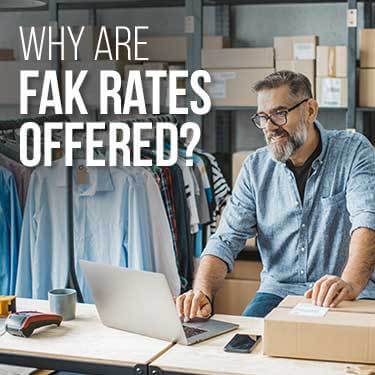
Calculating shipping rates gets more complex as variety increases. This is true for both ocean carriers and trucks. FAK rates are offered as a way of simplifying the price calculations for clients needing to ship large varieties of goods at the same time.
Rates for LTL shipping are based on the National Motor Freight Traffic Association’s (NMFTA) freight class system. Each commodity gets assigned an NMFC (National Motor Freight Classification) code that determines the tariff rate applied to it.
Imagine you need to ship five types of merchandise and each has a different freight class. Not only would you need to package each separately, but each would also need to be calculated individually. Quotes for such orders may take longer and be frustrating for both you and your carrier.
An NVOCC can offer FAK rates due to the sheer amount of containers that travel on cargo ships. The average ship can hold 10,000 - 21,000 TEUs - some even more. These ships are likely carrying containers for hundreds, if not thousands, of different companies.
Calculating individual commodities for each company, and then for each container, can turn into a logistical nightmare. FAK rates make it possible for quotes to go out quickly and minimize loading delays.
As an importer or business owner, getting your shipments in effectively and with as little red tape as possible saves time and money. FAK cargo options provide a way to ship a wide variety of commodities with efficiency.
The variety of different commodities businesses might ship can make LTL freight rates complicated to quote. Limited space on cargo vessels may cause some to take on FAK rate cargo that is easily invoiced over more complicated shipments that consume more time and labor.
Benefits to your business may come in the form of:
Each of these benefits is possible using FAK transportation. Some offer a way to save money, while others present you with opportunities to grow your business with less risk.
There are other factors involved that may affect the overall benefit. These include:
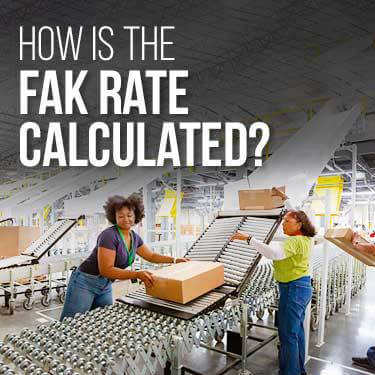
Working with a freight broker who can help you negotiate freight rates is one way to check your available options. FAK rates can be affected by a wide range of factors and getting expert advice can help you determine if it really is the best thing for your business.
Depending on how much you need to ship, FAK rates are calculated differently. LTL carriers often base FAK rate calculation on the average freight class rank of the different cargo being moved.
If you need to transport five different items, they may look at the average freight class among them. Based on items that range from class 55 to class 125, you may negotiate to pay the entire shipment as a class 85 tariff.
| Most Dense Items | Least Dense Item | Average Density |
| Class 55 (35 - 50 lbs/ft³) | Class 125 (7 - 8 lbs/ft³) | Class 85 (12 - 13.5 lbs/ft³) |
Whether an LTL offers an average density FAK classification may depend on other factors as well. If a higher class item is also difficult to package or takes up a significant portion of the space, the FAK rate may be higher. If different items can be put in the same crate or pallet and be stacked, you may be able to get a lower rate.
Ocean freight is calculated based on Harmonized Commodity and Coding System (HS). Commodities are assigned an HS code that determines the duty and tax rate paid when imported to the U.S. While weight and value are important, standard-sized shipping containers make handling easier.
Some shipping lanes also have higher rates than others. Because of these differences, NVOCCs will often base FAK rate calculations on container size, type, and shipping lane. Ocean carriers will also refer to these prices as spot rates.
In terms of containers, rates will be the least expensive on the most common size and type. Because of certain global conflicts and ongoing supply chain demands, ocean FAK rates change frequently - mostly to increase.
Containers commonly used for FAK freight include:
Different shipping lanes will also affect pricing. For example, if you are shipping a container from Shanghai, China to the U.S., it is likely to cost you double to ship to an east coast port versus a west coast port like Los Angeles/Long Beach.
Recent increases in fuel costs have also driven up pricing and affected FAK rates. Comparing the rising FAK rates for the four most popular lanes out of Shanghai, China can give you a basic idea.
| Port of Destination | June 2021 | June 2022 |
| Los Angeles, USA | $6,313 | $8,613 |
| New York, USA | $8,251 | $10,722 |
| Genoa, Italy | $10,472 | $11, 485 |
| Rotterdam, Netherlands | $10, 522 | $9, 799 |
While the cost difference between Los Angeles and New York is less than it used to be, both prices are still significantly higher. Averaged out for lanes worldwide, FAK shipping a 40-foot container is going to cost you about $8,570. Five years ago, before the pandemic and other current events, you would have paid about $3,420 on average.
Other factors such as distance, season, and any needed safety or security measures may add surcharges to the final price calculation. Either way, shippers should prepare to continue paying higher than average pricing.
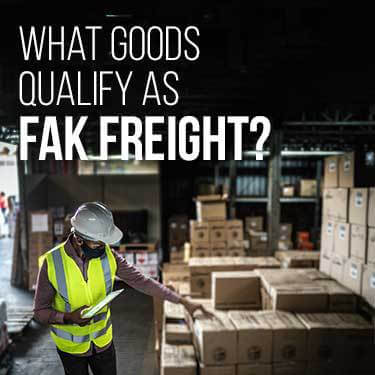
Most goods can be shipped as FAK freight one way or another. Even perishable goods can be shipped in reefer containers if a carrier offers the option.
Different carriers may have more specific regulations to qualify. For instance, they may require all goods to be within a specific weight or density range. If the load is too uneven, pricing may not be fair to one party or another.
LTL carriers need to be able to pick up other cargo. So if your shipment exceeds a certain capacity, they may recommend an FTL (Full Truckload) service instead.
Ships need to monitor tonnage to balance containers properly and to know when maximum weight has been reached. Shoreside cranes are used to move containers on and off ships, so how a container is packed also matters.
Some types of cargo can’t get FAK classification regardless of acceptable weight or size. Others may be prohibited because of weight and/or abnormal dimensions.
Most LTL carriers do not offer FAK services for goods that won’t fit in a standard dry trailer. NVOCCs operate much the same way and go so far as to have special classifications for cargo that isn’t able to fit in stackable containers of any size.
Characteristics that may prohibit cargo from shipping as FAK freight include:
This is by no means a definitive list and if you are looking to transport any of the above mentioned items, speak with a freight forwarder with experience in specialized cargo shipping.
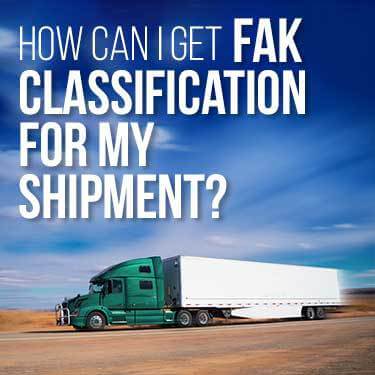
Whether or not your merchandise qualifies for FAK rates is up to the carrier you are working with. There is no specific government regulation overseeing FAK classification for cargo in the U.S.
To get FAK classification from your chosen carrier and be eligible for the rate, certain criteria usually need to be met. If you are only looking to get FAK rates from your NVOCC, it will be easier because many ocean carriers have a standard flat rate per container.
Ocean carriers will often have similar prices based on Platts Assessments that track market values of worldwide commodities.
For an LTL carrier, there may be more risk involved. They ship packages for multiple companies, but only one truckload at a time. FAK classification may depend on availability due to limited space.
Cargo shipments may have to meet all or some of the following criteria:
LTL carriers are less likely to grant someone FAK freight rates unless they have an established shipping history with them. Depending on the negotiated FAK rate, the LTL carrier may be operating at a slight loss unless the frequency of the shipments is high.
Some carriers will offer shippers a different kind of flat-rate price known as a class exception. This is specific to LTL carriers, so ocean carriers don’t offer it.
A class exception is one that covers a pre-specified range of freight classes and states that all goods that fall within that range will be treated as one class.
This is done by individual carriers. If you are switching from a carrier that has used class exceptions, don’t be surprised to find slightly different ranges in others.
A true FAK rate will cover all commodities within a shipment and be based on an average of each commodity.
As mentioned, it’s difficult for an LTL carrier to agree to terms like this. Depending on the range of commodities, the carrier rarely gets as good a deal out of it compared to a shipper. If a carrier is providing you with a range of freight classes that qualify for one rate, they are actually offering you a class exception, not a FAK rate.
If you have developed a good relationship with your carrier and ship frequently, it’s still possible to get a true FAK rate. Any benefits will depend on your shipping frequency and the range of commodities.
Whether your shipping needs are domestic or international, USA Truckload, powered by R+L Global Logistics can find you solutions that meet your needs. LTL carrier FAK rates may be the solution you’ve been waiting for.
For shipping within North America, we offer services for:
Work with USA Truckload and know that your shipments will be taken care of. Our industry experts pride themselves on offering the best customer service in the industry. You and your cargo are our main concern.
Reach out today for a service quote and get your goods in the hands of the people who need them.
R+L Global Logistics
315 NE 14th St., Ocala, FL 34470